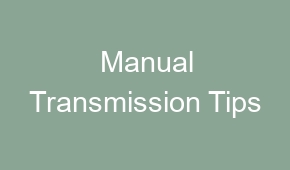Manual Transmission Tips

Mastering manual transmission requires practice and coordination. Engage the clutch, shift gears, and release the clutch smoothly for a seamless drive.
Manual transmission tips can greatly improve your driving experience and extend the life of your vehicle. One important tip is to always engage the clutch fully before shifting gears. This helps to prevent gear grinding and damage to the transmission. Another tip is to shift gears smoothly and avoid jerky movements, as this can also cause unnecessary wear and tear. Additionally, it is important to downshift properly when slowing down or coming to a stop, as this can help to maintain control and avoid putting stress on the transmission. Lastly, regularly checking and maintaining the transmission fluid levels can prevent overheating and ensure smooth shifting. Following these tips will help you get the most out of your manual transmission.
| 1. Proper clutch control is crucial for smooth manual transmission shifting. |
| 2. Rev-matching helps to downshift smoothly without causing jerking or clutch wear. |
| 3. Gradually release the clutch pedal while applying throttle for a smooth take-off. |
| 4. Avoid resting your hand on the gear lever to prevent premature wear. |
| 5. Practice hill starts to improve your clutch control on inclines. |
- 6. Always come to a complete stop before shifting into reverse gear.
- 7. Engage the parking brake when leaving your vehicle in neutral.
- 8. Avoid excessive clutch slipping to prevent damage and reduce wear.
- 9. Downshift to lower gears when approaching a stop to utilize engine braking.
- 10. Shift gears smoothly and avoid sudden, jerky movements for optimal transmission life.
What are the benefits of driving a manual transmission car?
Driving a car with a manual transmission offers several benefits. Firstly, it provides better control and responsiveness, allowing you to shift gears according to your driving style and road conditions. This can be especially advantageous for experienced drivers who enjoy a more engaging driving experience. Additionally, manual transmissions tend to be more fuel-efficient than automatic ones, as they don’t rely on a torque converter. Moreover, manual cars are typically cheaper to purchase and maintain than their automatic counterparts. Finally, knowing how to drive a manual transmission car can be a valuable skill, giving you the ability to drive a wider range of vehicles.
How do I properly shift gears in a manual transmission car?
Shifting gears in a manual transmission car requires coordination and practice. To shift up, start by pressing the clutch pedal fully and smoothly releasing the accelerator pedal. Then, move the gear lever from its current position to the next higher gear while still keeping the clutch pedal pressed. Once the gear is engaged, gradually release the clutch pedal while gently applying pressure on the accelerator pedal. To shift down, follow the same process but move the gear lever to the next lower gear instead. Remember to always shift gears at appropriate speeds and RPMs to avoid damaging the transmission.
What are common mistakes to avoid when driving a manual transmission car?
When driving a manual transmission car, it’s important to avoid certain mistakes. Firstly, don’t ride the clutch pedal, as this can cause premature wear and damage to the clutch system. Additionally, avoid resting your hand on the gear lever while driving, as it can put unnecessary pressure on the transmission. Another mistake to avoid is shifting gears without fully pressing the clutch pedal, as it can lead to grinding or difficulty in engaging the gear. Lastly, don’t abruptly release the clutch pedal when starting from a stop, as it can cause the car to stall. Practice smooth and controlled clutch engagement for a seamless driving experience.
How can I prevent stalling when driving a manual transmission car?
To prevent stalling when driving a manual transmission car, there are a few techniques to keep in mind. Firstly, make sure to fully depress the clutch pedal before starting the engine or shifting gears. This disengages the engine from the transmission, preventing stalling. Additionally, gradually release the clutch pedal while simultaneously applying slight pressure on the accelerator pedal when starting from a stop. This allows the engine to smoothly engage with the transmission. Finally, practice finding the clutch’s biting point, which is the point at which the engine starts to engage with the transmission, to prevent stalling when shifting gears.
What is double clutching and when should I use it in a manual transmission car?
Double clutching is a technique used in manual transmission cars to synchronize the engine and transmission speeds when shifting gears. It involves three steps: firstly, pressing the clutch pedal to disengage the engine from the transmission and shifting into neutral; secondly, releasing the clutch pedal and revving the engine to match the transmission speed; and finally, pressing the clutch pedal again and shifting into the desired gear. Double clutching is typically used in older cars or vehicles with non-synchronized transmissions to ensure smooth gear changes. In modern cars, the synchronization is usually done automatically.
What should I do if my manual transmission car won’t go into gear?
If your manual transmission car is having trouble shifting into gear, there are a few possible reasons. Firstly, check if the clutch pedal is fully depressed when attempting to shift gears. Insufficient clutch pedal depression can prevent gear engagement. Additionally, ensure that the gear lever is in the correct position for the desired gear. If the issue persists, it may indicate a problem with the clutch system, such as a worn clutch plate or a hydraulic issue. In such cases, it’s best to consult a mechanic to diagnose and address the underlying problem.
How can I improve my clutch control in a manual transmission car?
Improving clutch control in a manual transmission car requires practice and finesse. Firstly, pay attention to the clutch pedal’s biting point, the point at which the engine starts to engage with the transmission. Familiarize yourself with this point to achieve smooth gear changes. Additionally, practice feathering the clutch pedal, which involves applying slight pressure on the pedal to control the clutch engagement. This can help prevent stalling and achieve smoother shifts. Lastly, avoid riding the clutch pedal by keeping your foot off it when not actively shifting gears. Regular practice and experience will enhance your clutch control over time.
What can cause a manual transmission car to make grinding noises?
If your manual transmission car is making grinding noises when shifting gears, it may indicate a problem with the clutch system or transmission. One possible cause is a worn clutch, which can result in incomplete disengagement of the engine from the transmission. Another potential cause is a faulty synchronizer or gear teeth, which can lead to difficulty in engaging or disengaging gears. It’s important to have the issue diagnosed and repaired promptly by a qualified mechanic to prevent further damage to the transmission. Regular maintenance and proper driving techniques can help prevent such issues.
What is rev-matching and why is it important in a manual transmission car?
Rev-matching is a technique used in manual transmission cars to match the engine speed to the transmission speed when downshifting. It involves blipping the throttle to increase the engine RPM before engaging a lower gear. Rev-matching is important because it helps to smoothly engage the lower gear, preventing jerking or excessive wear on the clutch and transmission. By matching the engine and transmission speeds, rev-matching ensures a seamless transition between gears, improving overall drivability and reducing stress on the drivetrain components. Practice and mastering rev-matching can enhance your driving experience in a manual transmission car.
What is the clutch pedal for in a manual transmission car?
The clutch pedal in a manual transmission car is used to engage and disengage the engine from the transmission. When the clutch pedal is fully depressed, the clutch disengages, allowing the driver to shift gears without the transmission’s input shaft and the engine’s crankshaft being connected. Releasing the clutch pedal gradually engages the clutch, allowing power from the engine to be transmitted to the wheels. The clutch pedal acts as a control mechanism, enabling smooth gear changes and preventing stalling when starting or stopping the vehicle.
Can I switch from an automatic transmission car to a manual transmission car?
Yes, it is possible to switch from driving an automatic transmission car to a manual transmission car. However, it will require learning and practicing the specific skills involved in driving a manual. You will need to familiarize yourself with operating the clutch pedal, shifting gears, and maintaining proper clutch control. It’s recommended to take driving lessons or seek guidance from experienced manual transmission drivers to ensure a smooth transition. With practice and patience, you can become proficient in driving a manual transmission car and enjoy the benefits it offers.
How can I avoid rolling back when starting on an incline with a manual transmission car?
To avoid rolling back when starting on an incline with a manual transmission car, you can use a technique called hill start assist or hill-hold control, if your vehicle is equipped with it. This feature automatically holds the brakes for a few seconds after you release the brake pedal, giving you time to smoothly engage the clutch and accelerate without rolling back. If your vehicle doesn’t have this feature, you can manually prevent rolling back by using the handbrake. Engage the handbrake, release the foot brake, and gradually release the clutch while simultaneously applying slight pressure on the accelerator pedal.
What is the purpose of the gear ratios in a manual transmission car?
The gear ratios in a manual transmission car serve several purposes. Firstly, they allow the engine to operate within its optimal power and torque range across different driving conditions. By selecting the appropriate gear ratio, the driver can ensure efficient power delivery and maximize the vehicle’s performance. Gear ratios also enable the driver to control the vehicle’s speed and acceleration by matching the engine’s RPM to the desired driving conditions. Additionally, gear ratios contribute to fuel efficiency by allowing the engine to operate at lower RPMs during cruising or at higher RPMs for quick acceleration.
How can I determine the right time to shift gears in a manual transmission car?
Determining the right time to shift gears in a manual transmission car involves paying attention to the engine’s RPM and listening for cues from the engine. As a general guideline, it’s recommended to shift gears when the engine reaches its peak torque RPM, which is usually in the range of 2,000 to 3,500 RPM for most vehicles. However, this can vary depending on the specific car and driving conditions. Additionally, listening to the engine’s sound can help identify the optimal time to shift. As you gain experience, you’ll develop a sense of when to shift gears based on the engine’s performance and sound.
How can I extend the lifespan of my manual transmission?
To extend the lifespan of your manual transmission, regular maintenance and proper driving techniques are crucial. Firstly, ensure that the transmission fluid is changed at recommended intervals to maintain lubrication and prevent excessive wear. Check the owner’s manual or consult a mechanic for the specific fluid type and change frequency. Additionally, practice smooth and controlled shifting, avoiding harsh engagements or excessive slipping of the clutch. Use the appropriate gear for the driving conditions and avoid excessive RPMs. Regularly inspect and address any issues related to the clutch, synchronizers, or other transmission components to prevent further damage.
Can I shift gears without using the clutch pedal in a manual transmission car?
While it is possible to shift gears without using the clutch pedal in a manual transmission car, it is not recommended. Shifting without the clutch, also known as “power shifting” or “clutchless shifting,” puts significant strain on the transmission and can lead to premature wear or damage. It requires precise timing and rev-matching to match the transmission speed, which can be challenging and risky. Using the clutch pedal allows for smoother and safer gear changes by disengaging the engine from the transmission, preventing damage to the gears and synchronizers. It’s best to use the clutch pedal for shifting gears in a manual transmission car.
How can I drive a manual transmission car smoothly?
To drive a manual transmission car smoothly, it’s essential to practice proper clutch control and smooth shifting techniques. Firstly, pay attention to the clutch’s biting point, the point at which the engine starts to engage with the transmission, to achieve smooth gear changes. Gradually release the clutch pedal while simultaneously applying slight pressure on the accelerator pedal when starting from a stop. When shifting gears, ensure the engine is at an appropriate RPM and smoothly release the clutch while gently applying pressure on the accelerator. Practice and experience will help you develop a seamless and smooth driving style.
What should I do if my manual transmission car slips out of gear?
If your manual transmission car slips out of gear, it may indicate a problem with the transmission’s synchronizers or gear linkage. Firstly, ensure that you are fully engaging the gear and that the gear lever is in the correct position. If the issue persists, it’s advisable to have the transmission inspected by a professional mechanic. The problem could be due to worn synchronizers, damaged gear teeth, or a faulty gear linkage. Promptly addressing the issue can prevent further damage to the transmission and ensure safe and reliable operation of your car.
How can I prevent clutch wear in a manual transmission car?
To prevent clutch wear in a manual transmission car, it’s important to practice proper clutch control and driving techniques. Firstly, avoid riding the clutch pedal by keeping your foot off it when not actively shifting gears. Resting your foot on the clutch pedal can cause unnecessary friction and wear on the clutch components. Additionally, practice smooth clutch engagements and avoid excessive slipping or abrupt releases of the clutch pedal. Use the appropriate gear for the driving conditions and avoid excessive RPMs. By adopting these habits, you can minimize clutch wear and prolong the lifespan of your manual transmission’s clutch system.
What is the purpose of the clutch in a manual transmission car?
The clutch in a manual transmission car serves the purpose of connecting and disconnecting the engine from the transmission. When the clutch pedal is fully depressed, the clutch disengages, separating the engine’s input from the transmission’s output. This allows the driver to shift gears without the transmission’s input shaft and the engine’s crankshaft being connected. Releasing the clutch pedal gradually engages the clutch, allowing power from the engine to be transmitted to the wheels. The clutch acts as a control mechanism, enabling smooth gear changes and preventing stalling when starting or stopping the vehicle.



















